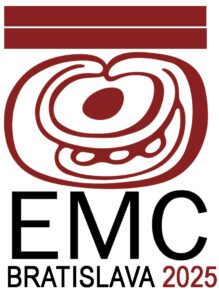EMC 30: Bratislava, Slovakia

The 30th Annual European Maya Conference is organized by Wayeb – the European Association of Mayanists – in cooperation with the Center for Mesoamerican Studies, Faculty of Arts, Comenius University in Bratislava. The conference will begin with an introductory lecture on the evening of Monday 24th November, followed by three days of workshops (25th-27th November), and concluding with a two-day symposium held from Friday 28th November to Saturday 29th November 2025.
The theme for the 30th European Maya Conference is TIME IN MESOAMERICA. The topic will be explored from a variety of perspectives.
During this conference, we will explore questions concerning timekeeping, and the significance of time, in Mesoamerica, including:
– Mesoamerican Calendars:
- How did different Mesoamerican cultures reckon with time and practice timekeeping? What were the key features and variations in calendar systems?
– Origins and development of calendars:
- How did Mesoamerican calendar systems evolve over time? What were the influences and innovations that shaped their development?
- Astronomical influences on calendar development: How did astronomical observations and knowledge shape the development and structure of Mesoamerican calendars?
– Perception of time:
- How did Mesoamerican cultures perceive the nature of time? What were the implications of cyclical concepts for their cosmology, rituals, and daily life?
- How is the concept of time represented in Mesoamerican languages and writing systems?
– Chronology in Mesoamerican archaeology:
- How do archaeologists use chronological data to understand the development and interactions of Mesoamerican societies? What are the challenges and opportunities in establishing accurate chronologies for the region?
- Dating methods and their applications: How are different dating methods used in establishing chronologies in Mesoamerican archaeology?
- Case studies in Mesoamerican chronology: Exploration of specific archaeological sites or regions and the challenges of establishing their chronological frameworks.
– Temporal rituals and ceremonies:
- How did Mesoamerican cultures mark and celebrate significant points in time? What were the roles of rituals and ceremonies in their understandings and experiences of time?
– Ethnohistorical perspectives on time:
- How do ethnohistoric sources, such as colonial-era documents and indigenous accounts, contribute to our understanding of Mesoamerican concepts of time and their changes over time?
- Continuity and change in timekeeping practices: From endogenous innovations to outside influence, how have indigenous communities in Mesoamerica maintained or adapted their timekeeping practices, both prior to European invasion and in the face of colonial and modern influences?
– Archaeoastronomy and time:
- How did Mesoamerican cultures incorporate astronomical observations and knowledge into the built environment and cultural practices?
- Alignment of structures and celestial events: How do the alignments of architectural features and urban planning reflect Mesoamerican understandings of time and the cosmos (including the temporality of the built environment and how it reflects broader cosmovision)?
– Archaeological approaches to the study of time:
- How do archaeologists investigate and interpret the material remains of past timekeeping practices, rituals, and ceremonies?
- What are the key archaeological methods and techniques used to study time in Mesoamerica, including the analysis of stratigraphy, artifacts, architecture, iconography, and epigraphy?
- How can archaeological data be integrated with other sources of information, such as ethnohistoric accounts and astronomical observations, to provide a more comprehensive understanding of Mesoamerican concepts of time?
- How do archaeologists’ own conceptions of time influence or guide interpretations of past cultures/lifeways in Mesoamerica?
The theme of the conference will be approached from various disciplinary points of view – including (but not restricted to) anthropology, archaeology, archaeoastronomy, biology, epigraphy, history, iconography, linguistics, and psychology – as well as interdisciplinary approaches exploring the intersection of these disciplinary perspectives.
